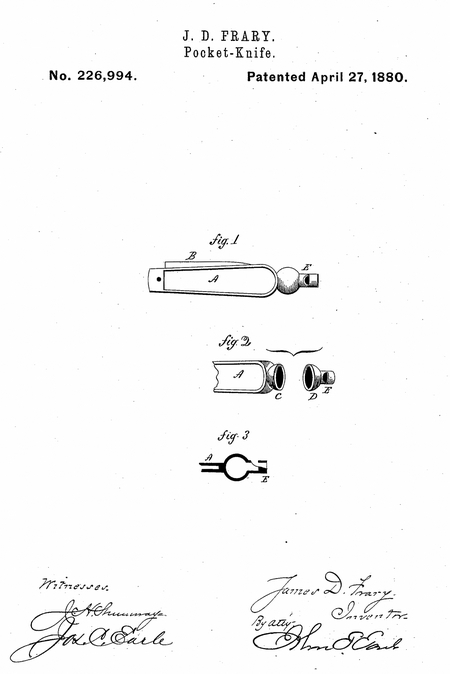James Darius Frary
- Born: 20 Sep 1833, Meriden CT
- Died: 25 Mar 1890
General notes:
Cutlery manufacturer
Events in his life were:
- He worked in 1851 as a manufacturer in Meriden CT in charge of his father's britannia shop.
- Partnership: George Marcellus Landers and John Woodruff Clark, in 1853-1889, in New Britain CT. As LANDERS, FRARY & CLARK.
- He appeared on the census in 1860 in Meriden CT. Listed as a manufacturer.
- He appeared on the census in 1870 in New Britain CT. Listed as a manufacturer.

- He was issued patent number 226,994 on 27 Apr 1880
JAMES D. FRARY, OF BRIDGEPORT, CONNECTICUT
POCKET-KNIFE
SPECIFICATION: forming part of Letters Patent No. 226,994, dated April 27, 1880.
To all whom it may concern:
Be it known that I, James D. Frary, of Bridgeport, in the county of Fairfield and State of Connecticut, have invented a new Improvement in Pocket-Knives; and I do hereby declare the following, when .taken in connection with the accompanying drawings and the letters of reference marked thereon, to be a full, clear, and exact description of the same, and which said drawings constitute part of this specification, and represent, inó
Figure J, side view; Fig. 2, detached view, illustrating the construction; Fig. 3, longitudinal section.
This invention relates to an improvement in that class of pocket-knives in which the handle is made from cast metal, the object being to combine a whistle with the handle; and the invention consists in the construction, as hereinafter described, and particularly recited in the claim.
A represents the cast-metal handle, which may be of any desirable form, and B the blade. At the end of the handle opposite to that where the blades are hinged a hemispherical shell, C, is cast as a part of the handle.
D represents a corresponding hemispherical shell, having a whistle, E, at its axis, and opening into the shell. The part D E is formed of like metal, and the two parts 0 D are set together and soldered, so as to form the spherical shape, as seen in Figs. 1 and 8.
The whistle opens into the shell, and by the shape greatly increases the volume of sound which may be produced by the whistle.
By casting one half the shell on the handle and the other half with the whistle the production of the knife is made very cheap. In fact, the construction of the whistle adds but a trifling cost to the knife.
I claimó
A cast-metal pocket-knife handle having the half-shell C cast as a part of it, and the other half-shell, D, cast as a part of the whistle E, and the two shells united, substantially as described.
James D. Frary
Witnesses:
J. H. Shumway
Jos. C. Earle

- Example: Pocket knife whistle, circa 1885, in Private Collection.
|



